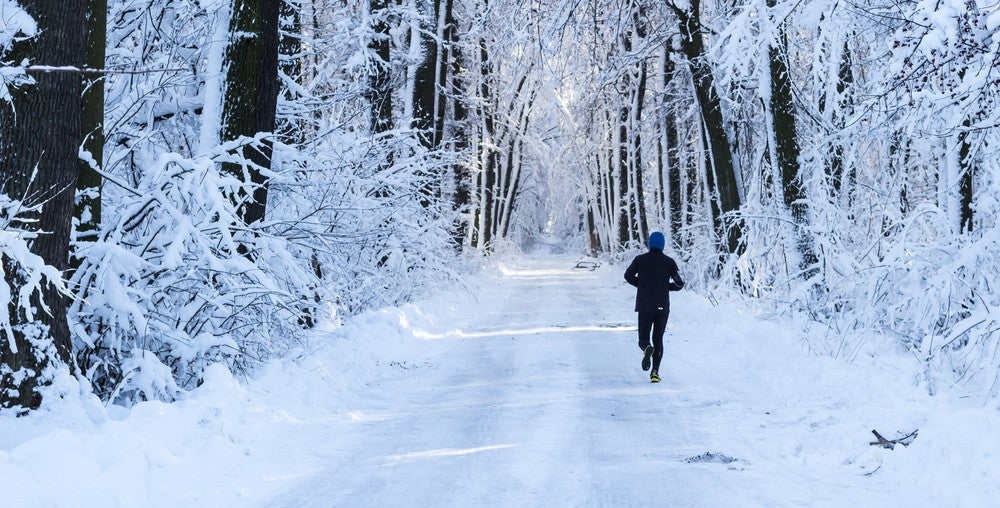

FREE SHIPPING AT $100
YOU'VE EARNED FREE SHIPPING!
FREE SHIPPING AT $100
YOU'VE EARNED FREE SHIPPING!
April 24, 2024 11 min read
As winter sets in and temperatures drop, many fitness enthusiasts may find themselves facing new challenges when it comes to staying active outdoors. While exercising in the cold can be invigorating, it also presents unique risks that need to be addressed to ensure a safe and effective workout.
From dressing appropriately for the weather to staying hydrated and knowing the signs of cold-related illnesses, there are several important factors to consider when exercising outdoors during the winter months. This article will provide tips and guidelines for staying safe and healthy while maintaining your fitness routine in the winter.
When engaging in outdoor activities like running or cycling in cold, winter weather, it's crucial to plan ahead to ensure a safe and enjoyable experience.
This includes choosing a safe surface to exercise on, such as well-maintained paths or roads that are free of ice and snow.
Additionally, considering your personal risk factors, such as age, fitness level, and any underlying health conditions, can help you make informed decisions about how long and how intense your workout should be, and when to take a break.
It's also wise to tell someone where you plan to run, cycle, etc., and when you expect to return, in case of an emergency. By taking these precautions, you can minimize the risks associated with outdoor winter workouts and make the most of the season.
Working out in the cold is not something to rush into. Let’s look at the various aspects involved in proper preparation if your winter fitness routine involves outdoor exercising.
Let start with the most important factor:

It's a good idea to know the expected temperature and wind chill factor before outdoor exercising in winter. Knowing these factors can help you prepare appropriately by choosing the right clothing and gear to stay warm and safe.
The temperature alone can give you an idea of how cold it will feel, but the wind chill factor takes into account the effects of wind on the perceived temperature. Wind can make it feel significantly colder than the actual temperature, increasing the risk of frostbite and hypothermia.
By checking the expected temperature and wind chill factor, you can dress in layers, wear appropriate footwear, and take other precautions to stay comfortable and safe during your outdoor workout.
The risk of frostbite and hypothermia during winter workouts depends on several factors, including the temperature, wind chill, duration of exposure, and how well you are dressed. However, it's essential to be aware of the signs and symptoms of these conditions so you can take action if necessary.

Frostbite occurs when skin and underlying tissues freeze due to cold exposure. The extremities, such as fingers, toes, nose, and ears, are most at risk.
Symptoms of frostbite include:
— Numbness or tingling in the affected area
— Pale, white, or grayish-yellow skin
— Hard or waxy-looking skin
— Pain or a burning sensation
— Blistering (in severe cases)
If you suspect frostbite, it's crucial to get out of the cold immediately and seek medical attention. Do not rub the affected area, as this can cause further damage.
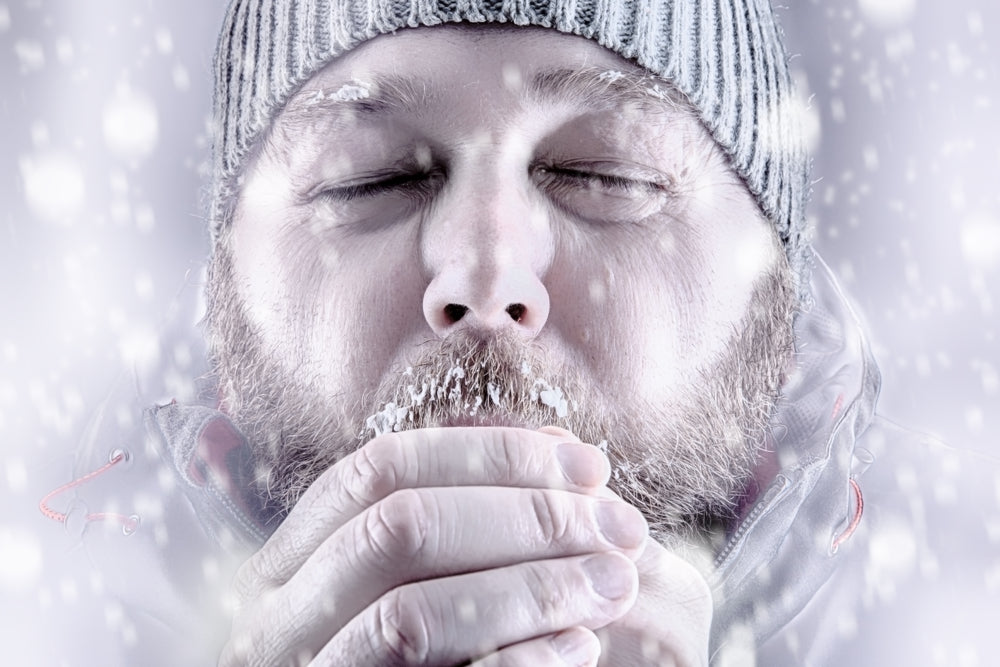
Hypothermia occurs when your body loses heat faster than it can produce it, causing your core body temperature to drop to dangerous levels.
Symptoms of hypothermia include:
— Shivering
— Fatigue or drowsiness
— Confusion or memory loss
— Slurred speech
— Loss of coordination
— Pale or cold skin
— Slow or shallow breathing
If you or someone else is experiencing hypothermia, seek medical attention immediately. Meanwhile, remove any wet clothing, wrap the person in blankets or warm clothes, and provide warm liquids if they are conscious and able to swallow.
To reduce the risk of frostbite and hypothermia during winter workouts, dress warmly in layers, cover exposed skin, and avoid prolonged exposure to cold temperatures. Pay attention to weather conditions and how your body feels, and be prepared to seek shelter and warm up if necessary.
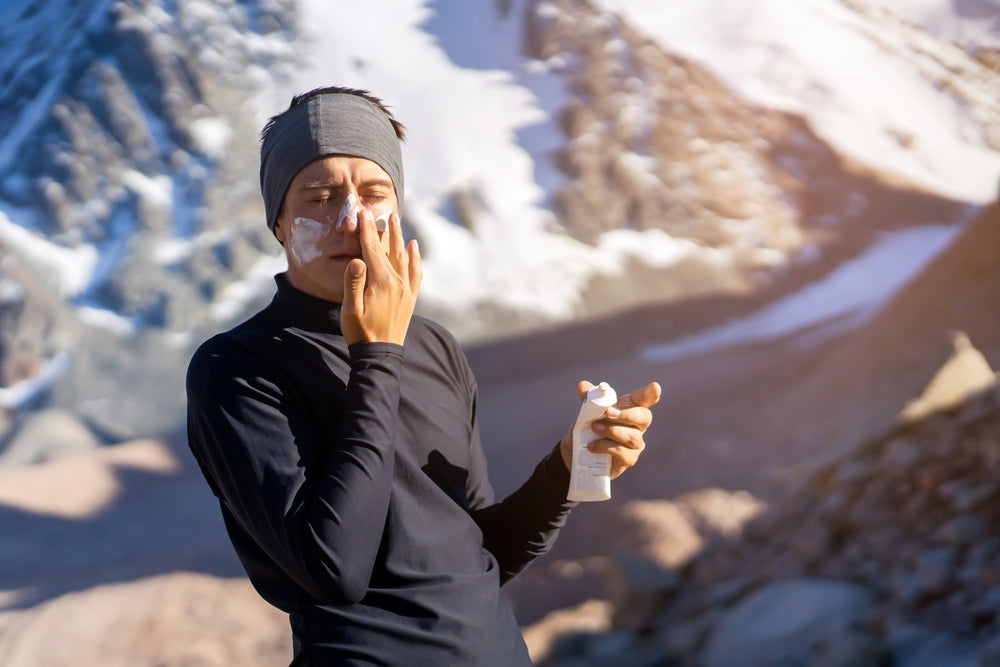
Is Sunscreen Really Necessary?
Yes, it is necessary to wear sunscreen for outdoor exercising in winter, especially in snowy conditions. Snow can reflect up to 80% of the sun's UV radiation, increasing your risk of sunburn and skin damage. Similarly, a protective lip balm is essential.
The appropriate SPF level for winter sun protection is the same as for any other time of year. The American Academy of Dermatology recommends using a broad-spectrum sunscreen with an SPF of 30 or higher. This level of SPF protects against both UVA and UVB rays.
Apply sunscreen to any exposed skin, including your face, ears, neck, and hands, about 15–30 minutes before going outside. Reapply every two hours or immediately after sweating or swimming.
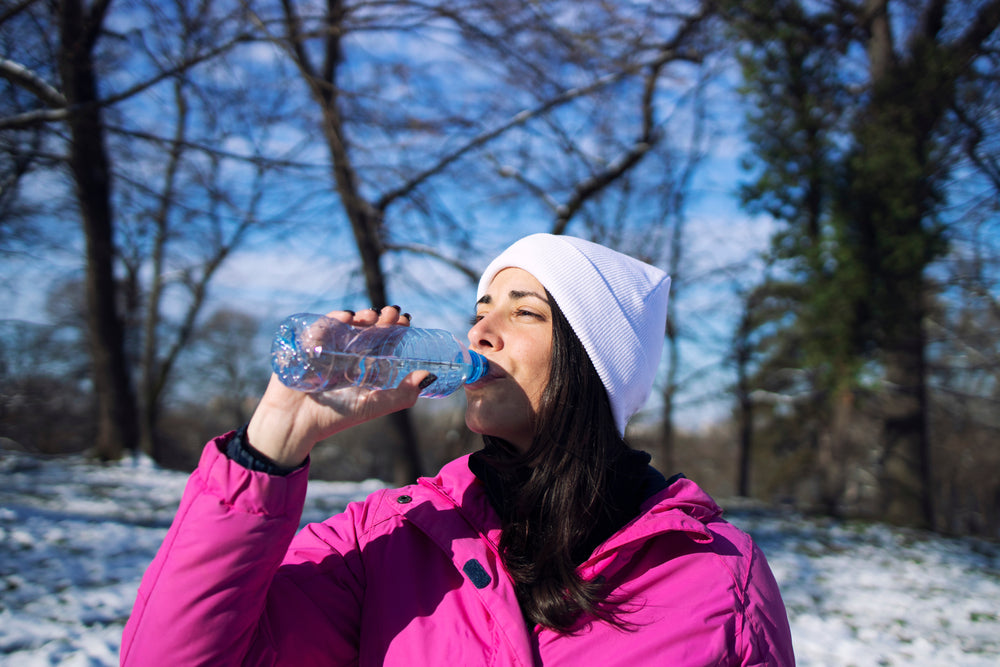
Staying hydrated is just as important during winter workouts as it is in the summer, even though you may not feel as thirsty in colder weather.
Here's why:
Sweating: You still sweat during winter workouts, even though it may evaporate more quickly in the dry, cold air. This can lead to dehydration if you don't replenish lost fluids.
Respiration: Breathing in cold air can cause your body to lose moisture, especially if you're exercising at a high intensity. Staying hydrated helps maintain the moisture balance in your body.
Performance: Dehydration can affect your performance, making you feel more tired and less able to push yourself during your workout.
Temperature Regulation: Proper hydration helps your body regulate its temperature, which is critical in cold weather to prevent hypothermia.
When it comes to the best beverages for staying hydrated during winter workouts, water is always a good choice.
You can also consider:
— Sports Drinks: These can help replenish electrolytes lost through sweat, especially if you're exercising for an extended period or at a high intensity.
— Warm Beverages: Warm drinks like herbal tea or warm water with lemon can be soothing and hydrating during cold weather workouts.
— Avoid Alcohol and Caffeine: These beverages can dehydrate you, so it's best to avoid them before and during your workout.
— Coconut Water: It's a natural source of electrolytes and can be a suitable alternative to sports drinks.
It's important to listen to your body and drink when you're thirsty, even if you don't feel as thirsty as you do in warmer weather.
As part of your preparation for working out in the cold, consider the following tips on your choice of clothing and footwear.
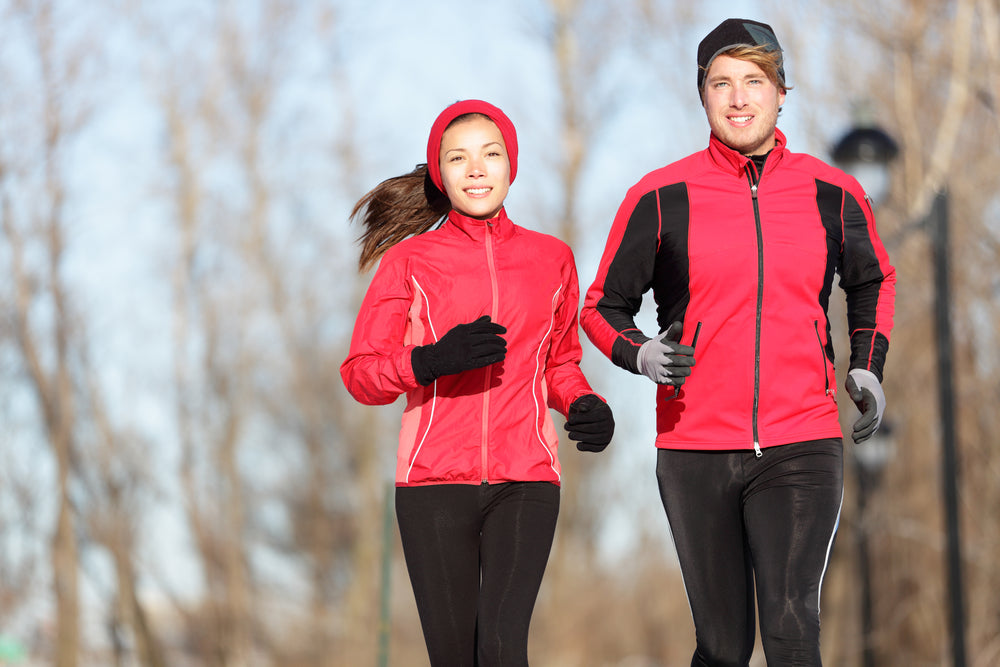
Layering properly is key to staying warm and comfortable during outdoor winter workouts. Here's how to do it effectively:
Start with a moisture-wicking base layer that fits snugly against your skin. This layer should wick sweat away from your body to keep you dry and comfortable. Avoid cotton, as it retains moisture and can make you feel colder.
Add an insulating layer on top of your base layer. This layer should be breathable and maintain body heat without being too bulky. Fleece or wool are suitable options for this layer, as they provide insulation even when wet.
Your outer layer should be windproof and waterproof to protect you from the elements. Look for a jacket that is breathable to prevent overheating and has features like adjustable cuffs and a hood to provide extra protection.
Don't forget to protect your extremities. Wear a hat that covers your ears, gloves or mittens, and a scarf or neck gaiter to protect your neck and face. Consider wearing thermal or wool socks to keep your feet warm.
As you heat up during your workout, you may need to adjust your layers to prevent overheating. Look for clothing with ventilation zippers or openings that you can adjust as needed.
If you're doing a high-intensity workout, you may need fewer layers to prevent overheating. Conversely, if you're doing a low-intensity workout or standing still for long periods, you may need to add more layers to stay warm.
If you sweat excessively, your clothing can become damp, making you feel colder. Consider bringing an extra layer to change into if you start to feel damp.
Before heading out for a workout, spend a few minutes outside to see if you're dressed appropriately. You should feel slightly cool when you start your workout, as you will heat up once you get moving.
— Visibility: Choose bright colors or high-visibility gear if you'll be exercising near traffic or in low-light conditions. Colors like neon yellow, orange, or pink can help you stand out.
— Reflectivity: Look for gear with reflective elements that will make you more visible to drivers and other pedestrians, especially if you'll be exercising in the early morning or evening when visibility is poor.

Choosing the right footwear for outdoor winter workouts is crucial for safety and comfort.
Here are some tips:
Look for shoes that provide adequate insulation to keep your feet warm in cold temperatures. Some shoes are specifically designed for winter conditions and feature insulated linings or materials.
Choose shoes that are waterproof or water-resistant to keep your feet dry in snowy or wet conditions. Wet feet can lead to discomfort and increase the risk of frostbite.
Opt for shoes with a high-traction outsole to prevent slips and falls on icy or slippery surfaces. Look for deep lugs or a rubber sole with a good grip.
While it's important to keep your feet warm, you also want shoes that are breathable to prevent sweat buildup, which can lead to cold feet. Look for shoes with breathable mesh panels or moisture-wicking linings.
Choose shoes that fit properly and provide enough room for thick socks if needed. Tight shoes can restrict circulation and lead to cold feet.
Look for shoes with good arch support and cushioning to provide comfort and reduce the risk of injuries, especially on uneven or slippery terrain.
Consider shoes with reflective elements to make you more visible to others, especially if you'll be exercising in low-light conditions.
The type of activity you'll be doing should also influence your choice of footwear. For example, if you're running, you'll need different shoes than if you're hiking or walking.
Before heading out for a workout, test your shoes on a small scale to ensure they provide the necessary traction and comfort for your intended activity and conditions.

There are several supplements that can be beneficial for fitness enthusiasts, especially during the winter months, when sunlight exposure (a source of vitamin D) may be limited.
Here are some supplements that can support your fitness routine in winter:
Since sunlight exposure is reduced in winter, supplementing with vitamin D can help maintain optimal levels. Vitamin D is important for bone health, immune function, and muscle function.
Omega-3s can help reduce inflammation, which is beneficial for recovery after workouts. They also support heart health and brain function.
Magnesium is involved in muscle function and energy production, making it essential for exercise performance. It may also help reduce muscle cramps and soreness.
Vitamin C is an antioxidant that can help support the immune system, which may be especially beneficial during the winter months when colds and flu are more common.
B vitamins, including B6, B12, and folate, play a role in energy production and metabolism, which are significant for maintaining energy levels during workouts.
While not a supplement in the traditional sense, adding protein shakes to your diet can ensure an adequate intake of protein, which is important for muscle repair and growth, especially for those who exercise regularly.
Before starting any new supplement regimen, it's a good idea to consult a healthcare provider or a registered dietitian to determine if they are appropriate for you and to ensure they won't interact with any medications you may be taking.
While this article focuses mainly on outdoor exercise routines, we’ll also provide a short list of indoor exercise options for those days when extreme weather traps you inside.

Here are some examples of both outdoor and indoor exercises that can help you stay fit during the winter months:
Walking or Hiking: Bundle up and enjoy a brisk walk or hike in a local park or nature reserve. Walking is a great low-impact exercise that can help you stay active and enjoy the winter scenery.
Running or Jogging: If you enjoy running, winter can be a great time to hit the pavement or trails. Just be sure to dress warmly and watch out for icy patches.
Cycling: Cycling is certainly feasible during winter; however, your location and the severity of your winter weather may limit the frequency of such outings.
Snowshoeing: If you live in a snowy area, snowshoeing can be a fun and challenging workout that gets you out into nature.
Sledding: Sledding isn't just for kids! Climbing back up the hill after each run provides a great workout for your legs and cardiovascular system.
Cross-Country Skiing: It is important to start small and build up your endurance and duration for cross-country skiing. You would rather not push yourself too far or hard and end up stuck or having a hard time getting home.
Ice Skating: Ice skating is a widely accepted winter pastime throughout the nation, and it can be engaged in at various levels, ranging from the casual enjoyment of skating around rinks to more strenuous pursuits such as speed skating or even as a component of hockey games.
Indoor Cycling: Whether you have a stationary bike at home or prefer a spin class at the gym, indoor cycling is a great way to get a cardio workout without braving the cold.
Strength Training: You can do strength training exercises at home using bodyweight exercises, dumbbells, resistance bands, or weight machines at the gym.
Yoga or Pilates: These low-impact workouts can help improve flexibility, strength, and balance, all of which are important for overall fitness.
Swimming: If you have access to an indoor pool, swimming is an excellent full-body workout that's easy on the joints.
Dance: Whether it's Zumba, hip-hop, or ballroom dancing, taking a dance class can be a fun way to work in some aerobic benefits as you stay active indoors.

Snow shoveling and raking leaves are also effective forms of cold-weather exercise. Moreover, don't overlook active housework like vacuuming and sweeping, not to mention mall walking and climbing stairs.
These activities engage multiple muscle groups and can help improve strength, endurance, and flexibility.
Just like any other form of exercise, it's essential to use proper technique and take breaks as needed to prevent injury. So, don't underestimate the workout you can get from these everyday tasks!
Your personal trainer can guide you by designing a routine with various exercises to help keep you motivated and engaged throughout the winter months.
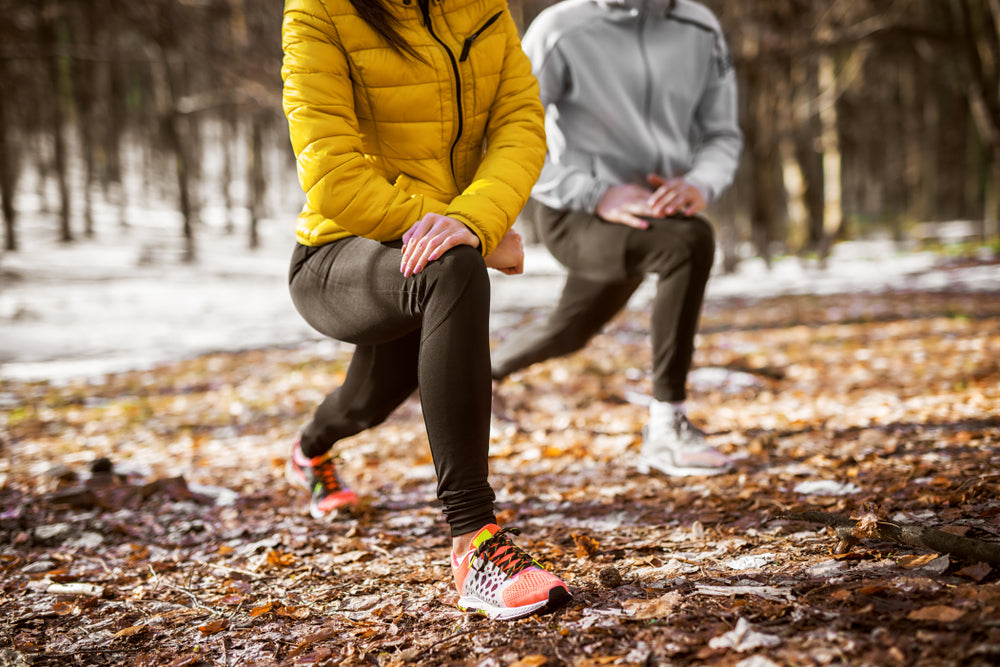
Warm-up and cool-down exercises are essential for any workout, but they are especially important in winter to prepare your body for the cold temperatures and reduce the risk of injury.
Here are some of the best warm-up and cool-down exercises for winter workouts:
Dynamic Stretches: Perform dynamic stretches that target the major muscle groups you'll be using during your workout. This can include leg swings, arm circles, and hip rotations.
Jumping Jacks: This full-body exercise increases your heart rate and blood flow to your muscles, preparing them for more intense activity.
High Knees: This exercise helps warm up your leg muscles and improve your range of motion.
Bodyweight Squats: Squats engage multiple muscle groups and help increase blood flow to your lower body.
Walking Lunges: Lunges warm up your leg muscles and improve balance and coordination.
Static Stretches: Hold stretches for 15–30 seconds to help reduce muscle tension and improve flexibility. Focus on the muscles you used during your workout.
Foam Rolling: Use a foam roller to massage and release tension in your muscles, helping to reduce soreness and improve recovery.
Gentle Cardio: Gradually decrease the intensity of your workout by walking or jogging slowly for a few minutes. This helps your heart rate and breathing return to normal.
Yoga or Pilates: These exercises can help improve flexibility, balance, and core strength while also promoting relaxation.
Hydrate: Drink water to rehydrate your body after your workout, especially in cold weather, when you may not feel as thirsty.
Warm-up and cool-down exercises are important in winter because they help increase blood flow to your muscles, making them more pliable and less prone to injury. They also help prepare your cardiovascular system for exercise and promote a faster recovery.
Staying safe during winter workouts requires a combination of preparation, awareness, and common sense. By dressing appropriately for the weather, staying hydrated, and being aware of the signs of cold-related illnesses, you can minimize the risks associated with outdoor winter exercise.
Additionally, incorporating indoor exercises into your routine and taking advantage of winter activities like snowshoeing and sledding can help keep you active and engaged throughout the season. By following these tips and guidelines, you can enjoy a safe and successful winter workout regimen.
